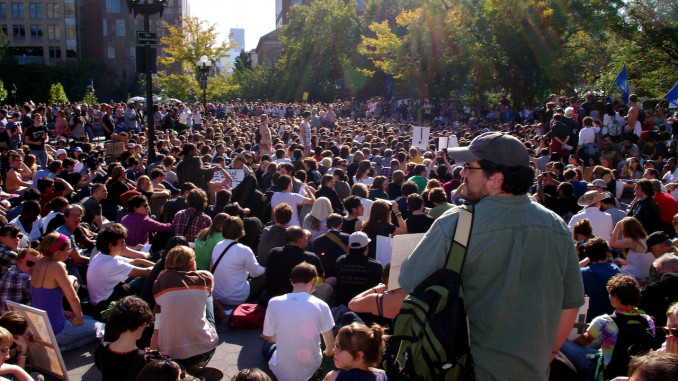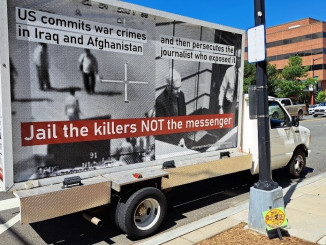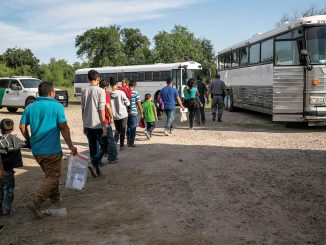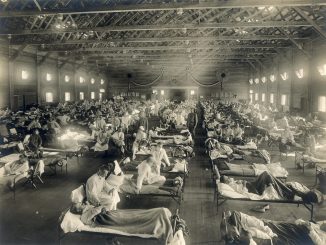
On September 17, 2011, two thousand protesters in New York occupied Zuccotti Park in Manhattan, in the heart of New York City’s financial district. The protesters were united by their outrage at the massive inequality between the 99% and the 1%. Their anger found an echo across the country. Soon after they occupied Zuccotti Park, hundreds of similar protests spread across the country, gathering in parks, city centers, and town squares, and setting up encampments, some with hundreds of tents.
The roots of Occupy can be found in the 2008 economic crisis. For years, big banks had offered sub-prime mortgages to poor and working-class people, knowingly giving them loans for houses they could never fully pay back, but could only make payments so long as housing prices continued to rise. But when housing prices started to fall around 2007, millions of people were left with mortgages they could no longer pay, and for houses worth far less than the balance of the mortgage. At this point, millions of people began to default on their mortgages.
As more and more mortgages went into default, banks and financial corporations fell into a crisis. Billions of dollars of their mortgage assets, along with trillions of dollars of other financial investments based on those loans, were now worthless. Some financial institutions declared bankruptcy, and as lending to corporations began to freeze, many corporations filed for bankruptcy, and millions of people were now facing foreclosure and eviction, and millions more began to lose their jobs.
Even though the 2008 crisis was caused by big banks and hedge funds, and their increasingly risky maneuvers to generate profit, without question it was the working class, the poor, and everyday people who had to pay for it. After 2008, governments across the world implemented harsh austerity measures, including mass layoffs, enormous funding cuts to pensions, education, healthcare, and a variety of social services.
In the U.S., for example, 29 states had lower education funding per student in 2015 than in 2008. State and local governments cut spending dramatically and payrolls declined by almost 3% after the crisis, leading to hundreds of thousands of lost jobs. Unemployment jumped past 10%. Many new jobs became increasingly more precarious — part-time, without benefits, with lower pay, and with inconsistent schedules. At the same time, the cost of living continued to increase, with average annual rents increasing by about 74% from 2008 to 2020.
But even while the majority of people were faced with slashed government assistance, wage cuts, and unemployment, big banks and corporations reaped trillions of dollars from the government. The Federal Reserve purchased 3.4 trillion dollars worth of risky assets from U.S. banks and financial institutions to ensure they had enough money to survive. Congress approved hundreds of billions of dollars’ worth of loans to big corporations on the brink of bankruptcy through the Troubled Asset Relief Program, while homeowners who faced eviction and couldn’t pay back their mortgages got next to nothing. In fact, about 80 percent of homeowners who lost their homes during the crisis and applied for relief were rejected by the banks, which preferred to keep people out of their homes instead of reducing their mortgage amounts.
The misery that the ruling class imposed on the poor and working class was a worldwide phenomenon — and there was worldwide resistance. In December 2010, Mohamed Bouazizi, a Tunisian street vendor, immolated himself in protest of the police brutality he faced and the impossibility of being able to make a living. Within a matter of days, his death triggered uprisings and mass protests across Tunisia which eventually spread all over the Middle East, including in Egypt, Libya, Syria, Yemen, and other countries. The protesters demanded not only political freedoms and democracy, but also opportunities for young people, an end to unemployment, and cheaper cost of living.
The Arab Spring was just the beginning of these protests. In the U.S., tens of thousands of protesters in Wisconsin occupied the state capitol for weeks to protest then-Governor Scott Walker’s attacks on public employee unions. In Spain, the Indignados movement mobilized thousands of people to protest the eviction of working people from their homes and the austerity measures of the Spanish government.
Occupy Wall Street emerged out of all of these mass movements against the austerity imposed by the 1%. It began when a Canadian magazine, Adbusters, called for an occupation of Zuccotti Park on September 17, 2011. Two thousand protesters, mostly recent college graduates burdened with student debt and facing an economy that offered them only unemployment and minimum wage jobs, took over the park. This occupation lasted almost two months, until the NYPD brutally broke up the encampment on November 15, 2011, arresting 200 people in the process. By then, however, other occupations had popped up around the country. People from all walks of life had come out to occupy their town centers and demand a better society.
The encampments around the country gave participants a taste of collective life. Mass meetings were held for people to discuss political issues and plan actions. Free political education libraries were set up at different occupations. There was also free food and free medical care. In many cases, the occupied encampments became temporary centers of political life and support for some in need. For the first time, many people saw that a different and better world was possible.
There were, however, limits to what these occupations could do. While the encampments brought people together and were a public demonstration of the anger and outrage people felt about the inequality in our society, they were rarely able to extend very far beyond these occupations of public spaces. In particular, the Occupy movement had a very difficult time extending beyond the occupation itself, and into the places where the 99% has the most power against the 1% — that is, into the working class and their workplaces, upon which the entire functioning of the society depends. It is that social power — that workers do everything that makes society run and makes the profits of the banks and corporations possible — that when tapped into, when organized, has the power to transform society. If Occupy could have reached more broadly into the working class, it could have unleashed an even more powerful movement.
But despite its limitations, Occupy is still an inspiration for many, especially as the problems we face have only grown worse. The climate crisis threatens all life. We also face global health emergencies, rampant inflation, and more. Occupy was a moment of political awakening for millions of people. It gave a voice to the rage against the 1% who have only further enriched themselves at the expense of the vast majority of people. It was part of a global movement against injustice. And most of all, it showed people that we can organize collectively and fight for a world where the poor and working class, the 99%, are in charge — not the billionaire capitalists of the 1%. That’s the fight that we must continue today.




